

Vol. 39 (Number 41) Year 2018 • Page 29
Marina Gennadyevna FEDOTOVA 1; Anastasia Viktorovna ZHIGLYAEVA 2; Elena Valentinovna STOLYAROVA 3; ,Kira Borisovna PRIGOZHINA 4; Alla Georgievna DMITRIEVA 5
Received: 17/06/2018 • Approved: 10/07/2018
2. Modern Approaches to HPR Management and Assessment
3. Structure and Quantitative Indicators of Regional Human Potential Assessment
5. Findings of approbation of the Proposed Evaluation Methodology and Model
ABSTRACT: Human potential is the main factor, a key aspect of the socio-economic development of the region. The article presents a systematic approach to the management of the human potential of the region, which is distinguished by its novelty and based on modern methods of system analysis, management and regional economy. In the course of the study, a model for managing the human potential of the region is formed, based on a system with a closed loop, consisting of a number of simpler functional subsystems. The structure and the mechanism for managing the human potential of the region based on the proposed conceptual model are substantiated. The scientifically grounded proposals and recommendations on the formation, use of the system at the regional level are presented. A system of indicators for the integrated assessment of the human potential of the region has been developed in linking them to strategic development guidelines. In total, eight fundamental quantitative indicators have been identified. Based on these indicators, the integral indicator (the level of the human potential of the region) is calculated. Using the formed system of indicators makes it possible to assess the magnitude of human potential, the effectiveness of the proposed management model. In addition, it is planned to monitor the dynamics of indicators, conduct interregional comparisons. Approbation of methodological tools was carried out on the example of Oryol region, Russia (2010-2015). Priority directions of development of human potential in Oryol region are determined and some recommendations for their implementation are given. |
RESUMEN: El potencial humano es el factor principal, un aspecto clave del desarrollo socioeconómico de la región. El artículo presenta un enfoque sistemático de la gestión del potencial humano de la región, que se distingue por su novedad y se basa en métodos modernos de análisis de sistemas, gestión y economía regional. En el curso del estudio, se forma un modelo para gestionar el potencial humano de la región, basado en un sistema con un ciclo cerrado, que consiste en una serie de subsistemas funcionales más simples. La estructura y el mecanismo para gestionar el potencial humano de la región según el modelo conceptual propuesto están fundamentados. Se presentan las propuestas y recomendaciones científicamente fundamentadas sobre la formación y el uso del sistema a nivel regional. Se ha desarrollado un sistema de indicadores para la evaluación integrada del potencial humano de la región al vincularlos con las directrices de desarrollo estratégico. En total, se han identificado ocho indicadores cuantitativos fundamentales. Sobre la base de estos indicadores, se calcula el indicador integral (el nivel del potencial humano de la región). El uso del sistema formado de indicadores permite evaluar la magnitud del potencial humano, la efectividad del modelo de gestión propuesto. Además, se planea monitorear la dinámica de los indicadores y realizar comparaciones interregionales. La aprobación de herramientas metodológicas se llevó a cabo en el ejemplo de la región de Oryol, Rusia (2010-2015). Las direcciones prioritarias del desarrollo del potencial humano en la región Oryol están determinadas y se dan algunas recomendaciones para su implementación. |
Human potential of the region (HPR) is described as a set of development expectations and opportunities related to individuals, companies and other regional economy entities and pointed towards achieving desired development goals for the regional society (Miroljubova and Chuchulina 2011). It represents a complicated scientific category that includes both economic and social aspects and requires and overall, multifaceted review.
Research findings dealing with human potential, its separate components, various approaches to the qualitative and quantitative assessment of the human potential magnitude are introduced in several papers by Russian and foreign scientists .
Foreign researchers who substantially contributed to the studies on this topic are represented by E. Denison, A. Toffler, R. Layard, W. Petty, A. Smith, K. Marx, A. Sen. S Bowles et al.
Such Russian scientists as T.I. Zaslavskaya, K.A. Kotomnova, Ye.V. Chuchulina, O.I. Ivanov, N.N. Morozova, S.N. Sakharovsky, A.O. Verenikin, S.Ye. Yolkin, A.B. Doktorovich, et al, have investigated human potential.
These days it seems reasonable that major tasks in this area include development of the integrated model for managing the HPR, methodological framework and regional human potential management mechanism. It is extremely important for implementation of regional development strategies, system-based coordination of regional management constituents.
The research papers highlight various human potential features called as elements, components and opportunities. These components constitute HP complicated structure. The analysis completed on the previously conducted research suggests that the most significant HP components include health, industrial/organizational, social, educational and demographic components (Lapshin 2013; Kravchenko and Sharkevich 2011). Some papers also describe such HP (in, particular, HPR) components as innovation, competitiveness, labor, activity, etc.
In addition to specific components highlighted, researchers denote HP levels. Thus, micro-, macro- and meso-levels of HP implementation have been identified. Besides, human potential features basic and active, individual and collective levels (Elkin 2013).
Along with investigating human potential structural components, its features and indicators, researchers give much attention to HP assessment. Since “human potential” notion implies versatility and diversity, this task is rather difficult. It is very difficult to give a qualitative assessment to the components like cultural, moral and spiritual (Eremina 2012).
However, the current situation suggests some quite mature approaches to calculation of HP quantitative indicators. Thus Human Development Index (HDI), calculated using living standards, education and health (life expectancy at birth) data, has proved to be the most widespread. Ye.V. Chuchulina highlights the following indices (indicators) of the regional HP full assessment: stock of human potential in regions (SHP), flow of human potential in regions (FHP), quality of human potential in regions (QHP), investment into human potential in regions (IHP).
Referring to sustainable management of human potential in regions, it is important to indicate fragmentary nature of studies dedicated to this topic and lack of an integrated model for managing human potential of the region. A similar model shall be developed taking into account various external and internal factors (with respect to the regional system) and shall provide for forecasting human potential status and development.
With regard to the analysis of the current techniques, we propose a hierarchically structured model of the human potential (so called, hierarchy model that has some similarities with the hierarchy of needs). The first basic level features the following components: health (physical and psychic), demography, socio-economic components. This level is called fundamental since it forms the basis serving to establish and develop other components. In case, the basic level is not in proper condition other components can hardly exist.
The second human potential structure level (with consideration of a particular region) includes the following components: education, profession and labor, competition and entrepreneurship. The second level correlates and interacts with the first one. For example, total health and income standards have a significant impact on the education quality and further actualization of the potential in the labor market.
The third top level is formed by research, scientific and technical, innovative and creative components. This level involves great intellectual capital, striving for maximum self-actualization, generation of new knowledge and innovative products. Intensive personal growth in diverse respects is the case in point (Gasper 2002).
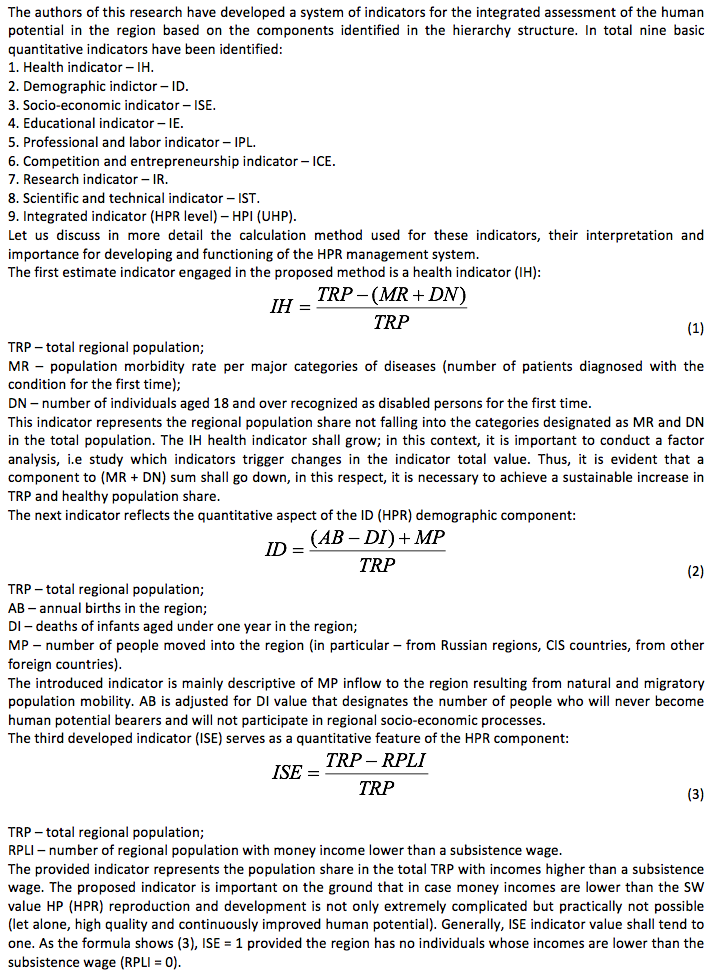
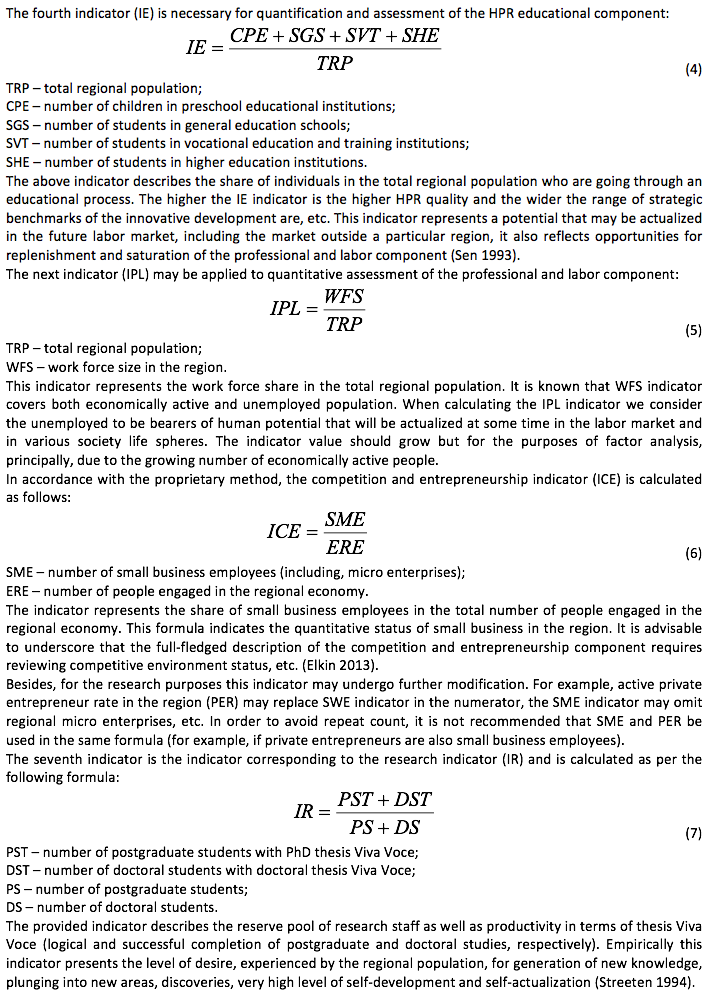
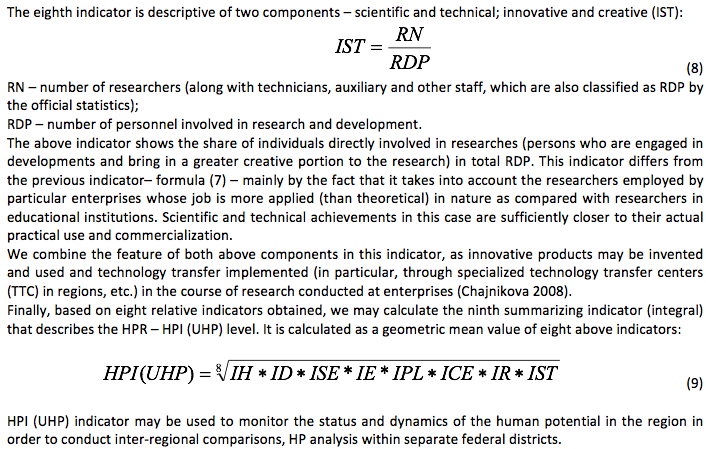
It is worth noting that integral indicators may be calculated at each HP structural level as well (basic, medium and top level). In this case, they will represent geometric mean values related to the indicators of the components that comprise each level. This procedure may be convenient for differentiated approach to management (Sen 1985) to ensure detailed research and assessment of HPR structural components.
Based on the identified components, considering all the above elements we have developed the model for human potential management system in the region. The HPR management system model is shown in Figure 1.
Figure 1
Regional model of the human potential management system
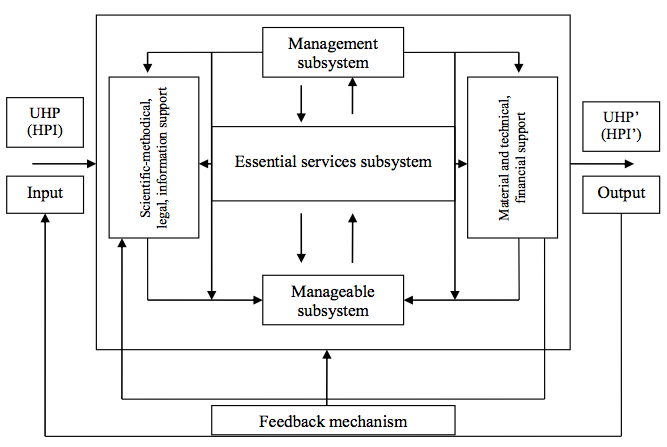
The model formed in this research encompasses the closed loop which interior part comprises continuously interacting simpler functional subsystems, thus ensuring HPR formation, development and actualization.
The system places the central emphasis on the essential services in the region (housing and utility services, transport, communications, etc.), since not only do they participate in the human potential dynamics, but also create proper environment in order to support operation of the management mechanism. Essential services subsystem in the region also serves as a link (and a “conductor”) between a management and manageable subsystem.
The level of human potential in the region - HPI (UHP) is an input indicator; its calculation method has been provided above – formula (9). In this instance, the provided indicator represents the expected and forecasted HPR level, which can be achieved through orchestrated and efficient operation of the system management mechanism. As it has been noted previously, separate or integral indicators at each HPR structural level (1-3) may be also reviewed for the research purposes.
The achieved and formed regional human potential - HPI’ (UHP’) - is located at the output end. It is evident that given proper operation of the system and its components, the HPI’ (UHP’) indicator actual (real) value shall be equal to HPI (UHP) indicator value or exceed it. Otherwise (in case the output value is lower than an input one) we may expect management or operational problems associated with the entire regional complex and thorough analysis of the current situation is required. In this instance, the adjusted feedback mechanism is of great importance.
The presented model also contains two important subsystems that ensure smooth implementation of the management process. We would like to note that each of such subsystems is strongly linked to the economic sectors, which, largely, supply required resources to them (then resources are redistributed in the identified subsystems deliberately for management purposes).
The proposed HPR management system model allows:
It is necessary to notice the importance of observing the following system formation (establishment) principles that ensure successful operation of the management system:
We will demonstrate the managerial decision-making algorithm in the context of the described system-based approach and HPR management mechanism (for convenient visualization shown in Figure 2). This chart presents major stages in the regional human potential management process. Compliance with a specific requirement (fulfilment of a condition) acts as a basic efficiency criterion. Certainly, the rate of change of HPR qualitative characteristics during management process is also important (Romashhenko and Kisova 2015). Should failure to comply with the requirements occur, it is recommended that a systematic analysis be conducted to reveal factors, causes, etc, contributed to HPR level decrease (in particular, to identify HP deformation and degradation up to its disappearance).
Figure 2
Generalized scheme for the implementation of HPR control mechanism concept
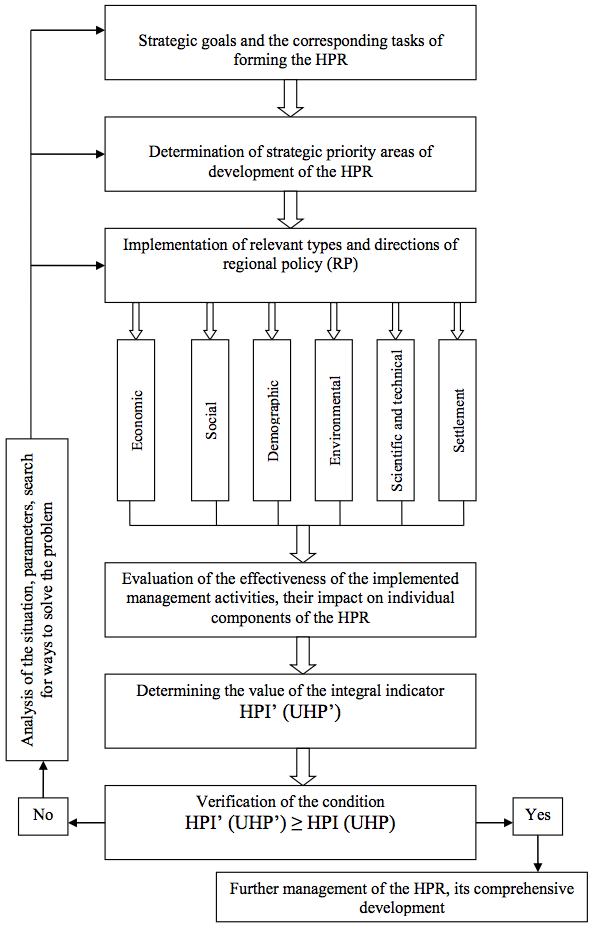
It is appropriate to note that return to any initial stage of the algorithm logic chain is possible (depending on revealed problems, their depth, complexity, etc.) The algorithm is available for repetition with respect to all stages and then summarized assessment of the obtained results follows. It is objectively needed to identify new goals and tasks, type and form of HP development in the region, etc. at specified intervals, even if there are no severe problems encountered.
However, it is recommended that the strategy be updated in whole only if it is not viable to adjust parameters and improve situation at separate stages (Petrishhe 2015) (i.e. strategic goals, priorities can be changed last of all after all other tools and methods have been applied and a comprehensive analysis completed).
It is advisable that the indicators developed for HPR integrated assessment, the management system model and a number of other identified provisions and elements be tested using a region (or a group of regions) as an example. As for this study, Oryol region was taken as an example. The eight main quantitative characteristics of the HPR components and the level of the region's HP for the period 2010-2015 have been calculated. The results are shown in the table.
Table 1
The indicators of the HPR in Oryol region in 2010-2015

Based on the results obtained, it is possible to conclude that three components have made the largest contribution to formation of the integral index value: socio-economic (ISE), vocational (IPL) and scientific and technical, combined in the calculation with innovative and creative (IST). In general, the values for each indicator differ in dynamics over the years only insignificantly.
It is evident that the values of the health component indicators and the cognitive-research component have been decreasing during the latest three years of the period under review. There has been a decrease in the number of postgraduate and doctoral students, as well as the number of defended graduates of post-graduate and doctoral studies, respectively. While analyzing the IH index dynamics, we have observed an increase in all major classes of illnesses against declining total population of the region.
The indicator of the demographic component (ID) has begun to increase since 2015. Referring to the structure of this indicator, we can note an increase in the number of deaths under the age of 1 year and increased number of arrivals in Oryol region. Nevertheless, the registered changes are local in nature and do not have a pronounced tendency (were recorded from 2014 to 2015).
The indicator that describes "critical state" of the HPR social and economic component (ISE) tends to its maximum value - one. However, based on the recommended factor analysis, it has been determined that this indicator is growing in Oryol region mainly due to reduction of the total population in the region, while the population with incomes below the subsistence level is increasing (in general, the indicator of the regional socioeconomic component has been decreasing after 2012). In this regard, as for Oryol region, it is not possible to deem the contribution of this component as positive in terms of quality.
The value of the integral indicator - HPI (UHP) – has been decreasing (also after 2012). This is a strong reason for an in-depth analysis, recognizing, in particular, the fact that the important health component, belonging to HPR basic structural level, is deteriorating significantly. In addition, other components of this level are also hard-pressed. Consequently, in the long run, further development of other regional HP components is under risk.
It should be noted that the obtained HPI (UHP) value can be used both as the output (actual value) - HPI '(UHP') and input HPI indicator (UHP) to assess HP of Oryol region in a year. That is, for example, in 2016 the obtained value of the indicator is transferred to the input, and then compared with the value achieved by the end of the year, etc. On the other hand, it is also possible to forecast the input indicator.
As for application of the developed HPR management system to Oryol region, it is important to emphasize the need for its harmonious implementation in the structure of the authorities. These include: Government of Oryol region, territorial bodies of federal authorities, state executive authorities of special competence, and other state bodies of Oryol region. The Youth Government of Oryol region, as well as non-profit organizations, firms (as subjects of the region's emergency management) have a great influence on the HP formation and development in this region.
Regional HP development and improvement of its quality should occur owing to the synergetic effect that results from interaction of the actual authorities (Zaslavskaja 2005) and other subjects related to regional HP management and the special structures (represented in the proposed model), which should have direct effect on certain HPR parameters.
Based on this study we are introducing some proposals on HP development in Oryol region using the developed methodology. First, it is necessary to devote special attention to the health, fertility and mortality of the population in order to reduce morbidity and overcome the decline in the total population of the region (Argunova 2013). Second, it is necessary to pursue a balanced social policy, strive to minimize the number of people with incomes below the subsistence minimum, purposefully implement the measures necessary to improve the standard of living of the population. Third, it is important to develop a competitive environment and implement measures to support entrepreneurship (including individual entrepreneurial initiatives) - based on the analysis of the ICE indicator.
In order to facilitate more successful implementation of priorities, the authors recommend that an "objective tree" be derived to include definition of the main objective (objectives) of the priority direction, followed by sub-objectives of the first, second, third levels, etc. It is also advisable to identify entities assigned to certain directions on each tree branch (particular departments, etc.). Finally, we can determine indicators on the share and relevance of each direction needed to achieve the main objective (for example, so that the sum of the values at each level be equal to one, etc.).
The findings and recommendations provided in this study could be used in the work of expert groups, as well as by regional authorities and the regional community to improve effectiveness of human resource management. It is possible to use the model and system of indicators in order to forecast and assess the status and dynamics of the regional human potential taking into account the system-forming factors of the internal and external environment.
Further development of the methodology involves the following studies: develop various methods for HPI (UHP) forecast and describe them; carry out correlation-regression analysis in order to establish particular relationships, dependencies among the HP components (their direction, strength, etc.) as well as assess the contribution of various factors; carry out a comprehensive study of the HP level in various regions (presumably - in the context of federal districts), implement interregional comparison and factor analysis.
The article has been prepared within the project “Managing the human potential of the region on the basis of a systematic approach” performed during the competition for the performance of research work of students, graduate students and young scientists (Plekhanov Russian University of Economics).
Miroljubova T. V. and Chuchulina E. V. (2011). Regional'naja model' chelovecheskogo potenciala [Regional model of human potential]. Vestnik Permskogo universiteta [Bulletin of Perm University], 3(10), 65-73.
Lapshin V. A. (2013). Strukturnye komponenty chelovecheskogo potenciala [Structural components of human potential]. Nauchnyj potencial: raboty molodyh uchjonyh [Scientific potential: the work of young scientists], 1, 259-263.
Kravchenko E. N. and Sharkevich I. V. (2011). Osobennosti razvitija chelovecheskogo potenciala regionov sovremennoj Rossii [Features of human potential development in the regions of modern Russia]. Jekonomika regiona [Economy of region], 3, 71-79.
Elkin S. E. (2013). K voprosu ob jeffektivnosti upravlenija razvitiem chelovecheskogo potenciala [On the issue of the effectiveness of human development management]. Vestnik Omskogo universiteta [Bulletin of Omsk University], 3, 137-142.
Eremina E. V. (2012). Znachenie chelovecheskogo potenciala v razvitii regiona [The importance of human potential in the development of region]. Sovremennye issledovanija social'nyh problem [Modern research of social problems], 5(13), 114-120.
Gasper D. (2002). Is Sen’s Capability Approach an Adequate Basis for Considering Human Development’ Review of Political Economy, 14 (4).
Sen A. K. (1993). Capability and Well-Being, in Martha Nussbaum and Amartya Sen (Eds) The Quality of Life. Oxford University Press.
Elkin S. E. (2013). O sushhnosti processnogo podhoda k upravleniju razvitiem chelovecheskogo potenciala [On the essence of the process approach to managing human development]. Sibirskij torgovo-jekonomicheskij zhurnal [Siberian trade and economic magazine], 1(17), 132-137.
Streeten P. (1994). Human Development: Means and Ends. Human Development.
Chajnikova L. N. (2008). Teoreticheskij aspekt ponjatija konkurentosposobnosti regiona [The theoretical aspect of the notion of regional competitiveness]. Vestnik Tambovskogo universiteta [Bulletin of Tambov University], 11(67), 505-509.
Sen A. K. (1985). Commodities and Capabilities. Oxford: Oxford University Press.
Romashhenko T. D. and Kisova, A. E. (2015). Ocenka faktorov formirovanija i razvitija chelovecheskogo potenciala: regional'nyj aspect [Assessment of the factors of formation and development of human potential: the regional aspect]. Vestnik Voronezhskogo gosudarstvennogo universiteta [Bulletin of Voronezh State University], 1, 35-39.
Petrishhe, V. I. (2015). Demograficheskie processy i innovacionnoe razvitie Orlovskoj oblasti [Demographic processes and innovative development of Oryol region]. Vestnik gosudarstvennogo i municipal'nogo upravlenija [Bulletin of State and Municipal Management], 1 (16), 116-123.
Zaslavskaja, T. I. (2005). Chelovecheskij potencial v sovremennom transformacionnom processe [Human potential in the modern transformation process]. Obshhestvennye nauki i sovremennost' [Social sciences and modernity], 3, 5-16.
Argunova, V. N. (2013). Chelovecheskij potencial sovremennogo rossijskogo regiona: zhiznennye strategii i innovacionnye resursy (na primere Ivanovskoj oblasti) [Human potential of the modern Russian region: life strategies and innovative resources (by the example of Ivanovo region)]. Vestnik NGTU im. R. E. Alekseeva [Bulletin of the NSTU], 1, 28-36.
1. Plekhanov Russian University of Economics, Stremyanny lane 36, Moscow, 117997, Russia. Email: mgfedotova@yandex.ru
2. Plekhanov Russian University of Economics, Stremyanny lane 36, Moscow, 117997, Russia. Email: anastasia.zhiglyaeva@gmail.com
3. Plekhanov Russian University of Economics, Stremyanny lane 36, Moscow, 117997, Russia. Email: elena100lyarova@gmail.com
4. Plekhanov Russian University of Economics, Stremyanny lane 36, Moscow, 117997, Russia. Email: kira.prigozhina@gmail.com
5. Plekhanov Russian University of Economics, Stremyanny lane 36, Moscow, 117997, Russia. Email: allagdmitrieva@gmail.com